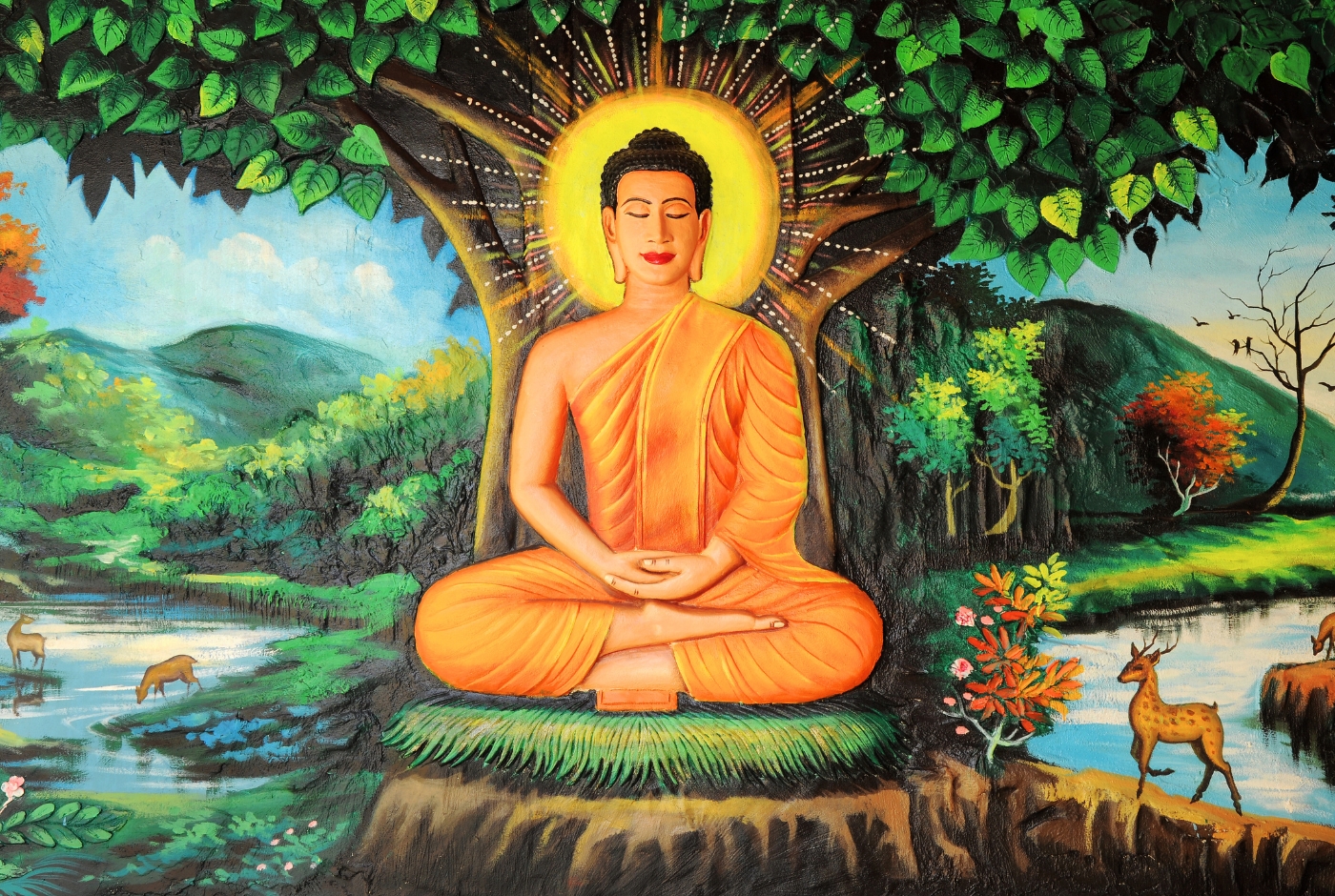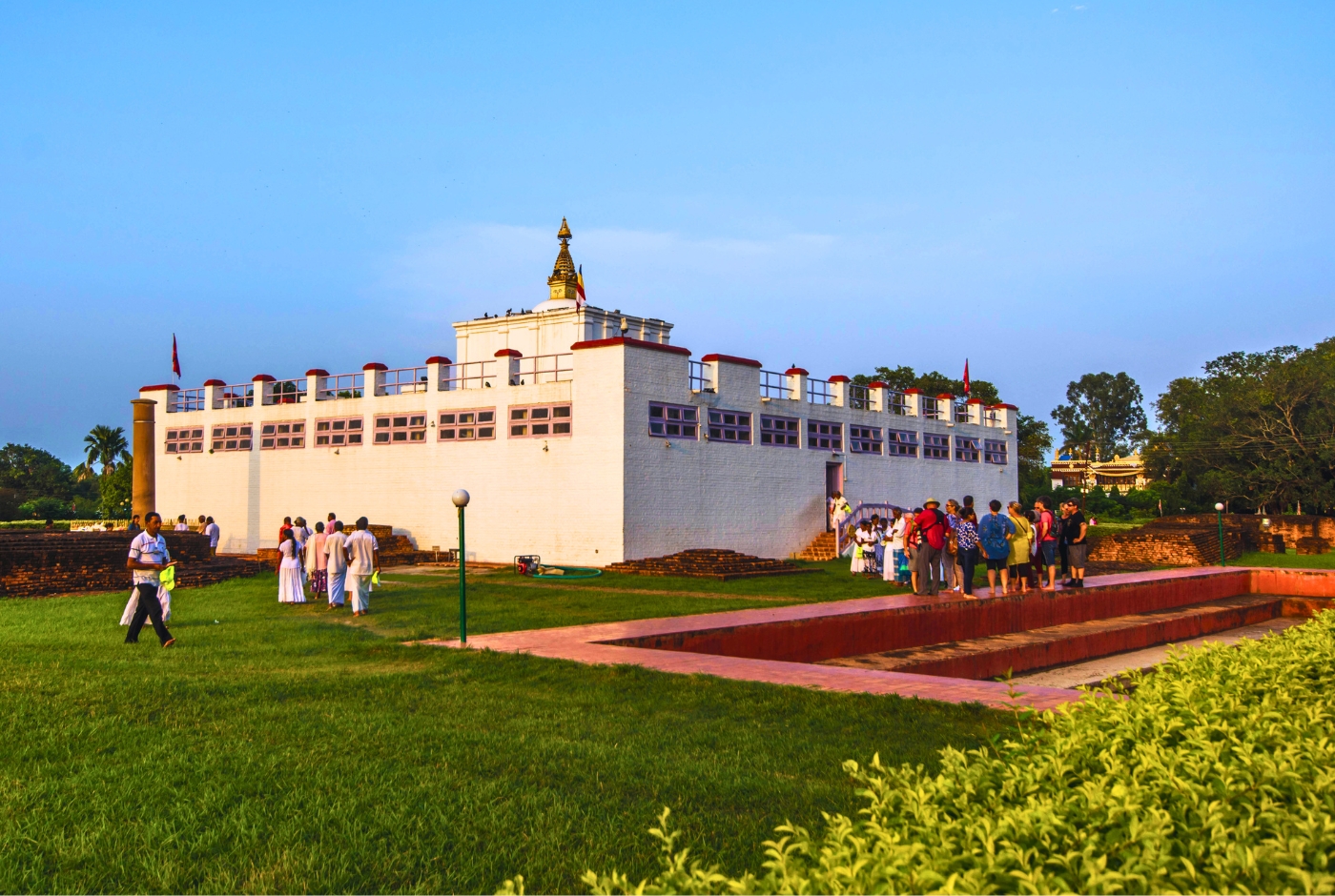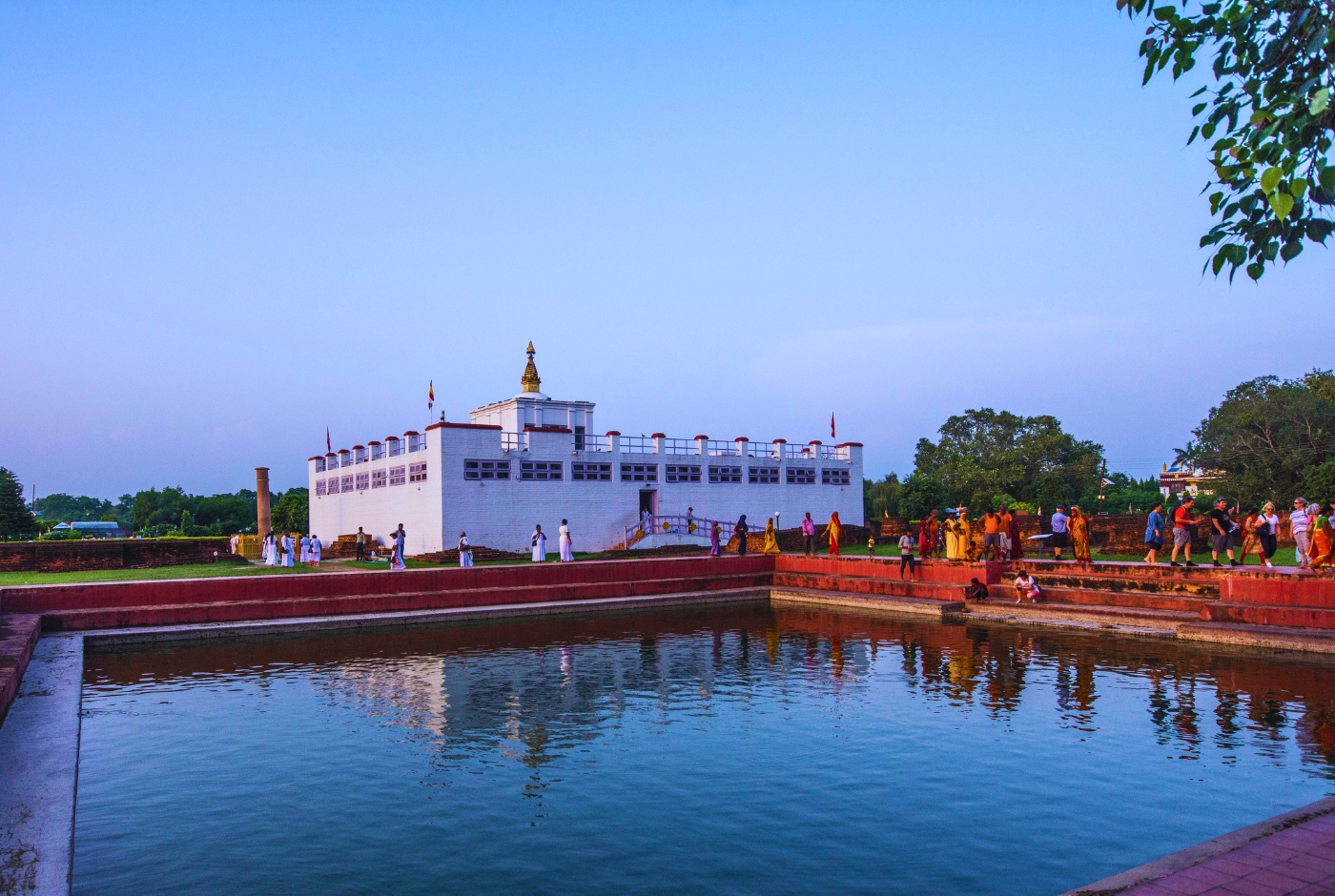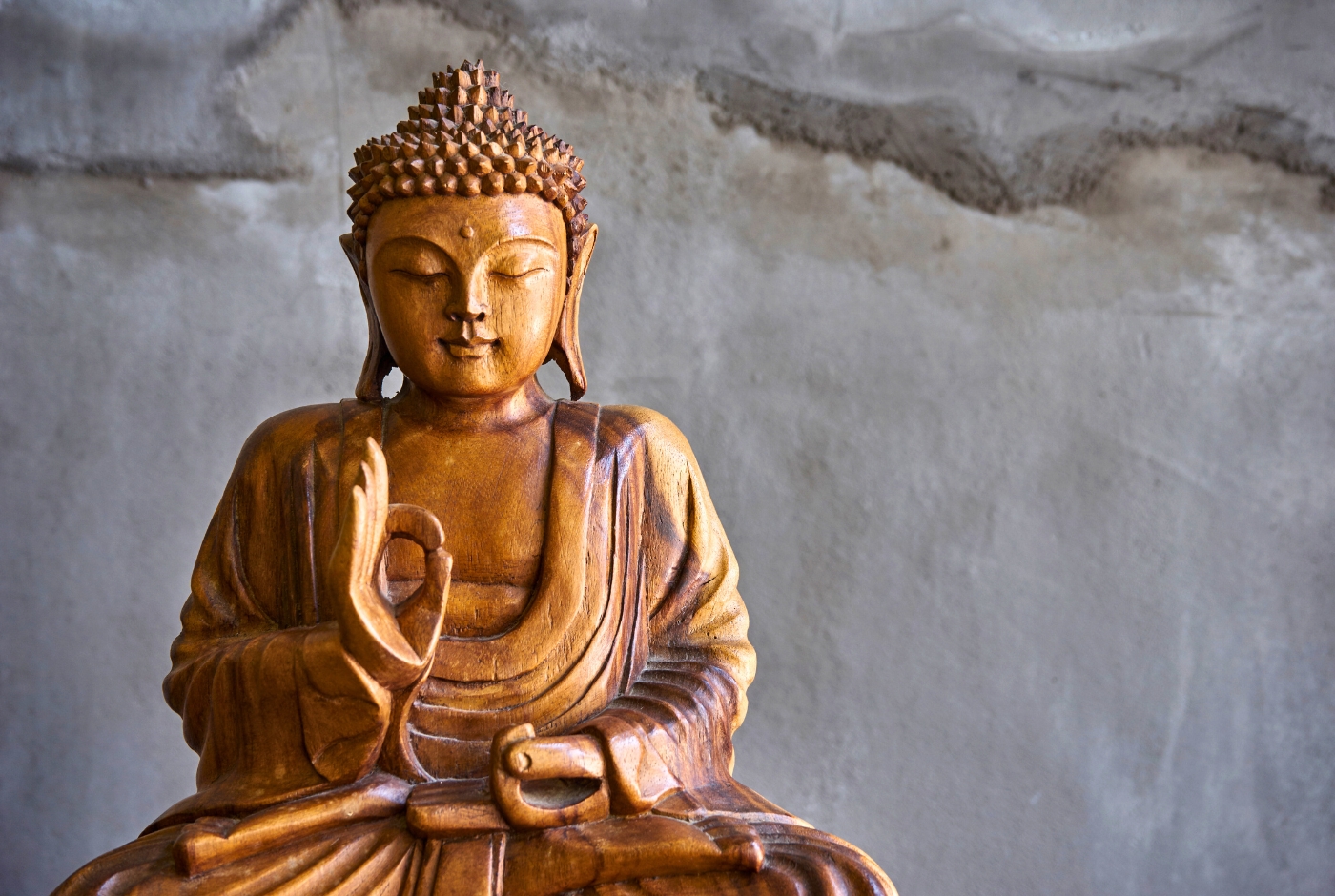Lumbini- Lord Buddha's birthplace is a sacred pilgrimage site for Buddhist and Hindu followers in Nepal's Rupandehi District.
Being a multicultural country, Nepal displays religious and ethnic harmony amongst its diverse tribes. However, each ethnic group has a different set of customs and traditions, Nepalese respects each other's cultural practices. Nepal's larger population follows the Hindu religion, and Buddhism coming in second place.
In 623 BC, queen Maya Devi of Lumbini gave birth to Siddhartha Gautama. Siddhartha Gautama, who achieved enlightenment after meditating for 45 days, became Lord Gautam Buddha. He was an ascetic and a sage, and it was his teaching on which Buddhism was formed. Lumbini is one of the many pilgrimage attractions that sprung up in places fundamental to Gautama Buddha's life. The sacred site is a World Heritage Site recognized by UNESCO in 1997, and it has many notable temples and landmarks.
The famous monuments around the holy place are Maya Devi Temple, the Asoka pillar, and several others. Many monuments, monasteries, and museums surround the heritage site. There is also the Lumbini International Research Institute within the sacred place where information regarding Buddhism, Buddha, and heritage sites is available. There's the Puskarini, a Sacred Pond, where Buddha's mother had a ceremonial dip before giving birth to him. It was also here where Buddha had his first shower. Along with these monumental sites, other places are an integral part of Budhha when he was just a prince. In the below section, we explore the crucial landmarks of Lumbini that represent the memorabilia of Lord Gautam Buddha before he found his enlightenment.
Lumbini Location: Where is Lumbini Located?
Lumbini, the birthplace of Siddhartha Gautama (the Buddha), is located in the Terai region of Nepal not in India, specifically in the Rupandehi district. It's a UNESCO World Heritage Site and a significant pilgrimage site for Buddhists. Specifically, it is situated in the Terai plains of Rupandehi. Lumbini is renowned as the birthplace of Siddhartha Gautama, who became the Buddha, and is a UNESCO World Heritage site.
The area is characterized by its historical ruins, including the Ashoka Pillar and the Maya Devi Temple.
Detailed Location:
- Province: Lumbini Province.
- District: Rupandehi.
- Region: Terai (southern plains) of Nepal.
- Distance from Kathmandu: Approximately 260 kilometers.
- Distance from Pokhara: Approximately 169 kilometers.
- Distance from Indian Border (Sunauli): About 1 hour by car.
The Story of Lord Buddha: His Life, Teachings, and Legacy
Lord Buddha is the primary figure in Buddhism. Buddhists recognize him as an enlightened teacher who attained complete Buddhahood and shared his insights to help sentient accept death, rebirth, and suffering. Buddhists believe accounts of his life and discourses, monastic rules have been summarized after his death and memorized by his followers. He passed down various teachings attributed to him verbally, and it was about 400 years later, people wrote down his pearls of wisdom and teachings.
Gautam Buddha was a prince born in Kapilvastu of Lumbini before becoming a sage. He was born to Suddhodana as a Kshatriya. His mother was a Koliyan princess before becoming a queen of Kapilvastu. Gautam Buddha came from a fulfilling life that was his destiny. As per the myth, Maya Devi conceived Gautama unconventionally. One night his mother saw a dream that a white elephant with six tusks entered her right, and ten months later, she gave birth to Siddhartha Gautama. In the Shakya tradition, when it is time for delivery, the pregnant mother goes to her maternal home to give birth.
On the way to her maternal home, she went into labor and gave Gautama birth beneath the sal tree. He was named Siddhartha, a name that means "he who achieves his aim". During the child's birth festivities, the hermit seer Asita visited the infant leaving his mountain abode, and proclaimed that the child would either become a great king or a great sadhu. The Asita concluded that after Siddhartha placed his feet in Asita's hair, and Asita examined the traditional recital's birthmarks. On the fifth day, King Suddhodana arranged a naming ceremony, inviting eight Brahmin scholars to predict the future. They all gave a dual forecast that the kid would either become a great king or a great prophet.
His mother's younger sister Maha Pajapati raised Siddhartha. Being a price, a life of luxury, was a certainty for him.
At the age of 26, his father arranged his marriage with Princess Yosodhara. She gave a son named Rahula to the Royal family. King Suddhodana was skeptical about his son's future since it was a dual prediction. To prevent him from choosing the later fate, he created a very luxurious life for his son within the confines of his palace. Inside the opulent palace, people shielded Siddhartha from all human suffering. Surrounded by joy and no suffrage, Siddhartha had never seen human illnesses or human hardships during his stay in the palace. When he was married, and his wife had given birth to a son, he eventually allowed Siddhartha to leave the castle to take a hometown tour. He thought that he would not want to leave his life because of his love for his son. Suddhodana felt that his obligation, devotion, and affection for his son Rāhula would help Siddhartha remain.
As Siddhartha walked out of the palace for the first time, his father ordered all sick, elderly and disabled people out of the streets.
But coincidently, while Siddhartha was visiting the city for the first time in his life, he came across an older person. Seeing that was very peculiar for him as he had never seen an older person in his life. Nor a sick person. Nor a corpse.
He asked, with curiosity, what was wrong with the guy.
"He's aged, sir," answered his charioteer-Channa, "all humans grow old and die at some stage or another. After that, the prince went on further trips outside the palace. He met sick, poor, and a monk on his tour. They saddened him, and initially, he struggled to overcome age, illness, and death. After witnessing such a thing, Siddhartha felt more out of place at the palace. He felt how he can enjoy luxury when there was so much suffering outside the palace walls. His father ensured that Siddhartha had everything he could ever want or need. But the Buddhist scriptures state that the future Buddha believed that material prosperity was not the primary objective of life.
Gautama left his place for mendicant life accompanied by Channa and riding his horse Kanthaka. He left his abundant life at the castle, his family, his wife, and his son to pursue more significant meaning in life. Myths suggest that Siddhartha muffled the horses to keep the guards from learning about his departure. He first went to Rajagaha and began his monk life by begging for alms in the streets. One day, he came across King Bimbisara and offered him his throne. Siddhartha firmly rejected the offer and went on his journey, promising to visit the kingdom of Magadha after attaining enlightenment. He then met two hermit teachers of yogic meditation under whom he practiced.
Path to Enlightenment
In the beginning, he tried to find enlightenment by depriving himself of materialistic things, foods and practicing self-humiliation. He limited his food intake to nuts and a leaf only, which led him to near death due to starvation. One day while bathing, he collapsed and almost drowned. A village girl named Sujata saves Gautama and seeing his state feed him some Kheer. His emaciated appearance led the girl to believe him as a spirit, and she was granted her wish. After this incident, Siddhartha started to rethink his course. Then he recalled a moment in his childhood when he had watched his father initiate the plowing season. Gautama achieved aconcentrated state. At that time, he was blissful and refreshing and was in the jhāna. When meditating for enlightening, it happens that he was below the Bodhi tree—in Bodh Gaya, India, when he affirmed never to awake until he had attained the truth.

He gained his enlightenment at the age of 35 after meditating for 49 days. After attaining enlightenment, he became "the awaken one" and became known as Buddha. According to some of the Pali canon's sutras, he realized complete insight into the Four Noble Truths at his awakening time. Thereby Buddha gained salvation from moksha- the endless cycle of rebirth, pain, and dying again. He found his Nirvana- an extinguishment of the "fires" of desire, hate, and ignorance that keep the cycle of pain and rebirth going.
Nirvana is regarded as the "end of the world," in that no personal identity or boundaries of the mind remain. As the legend says, a human person possesses the Ten Characteristics, belonging to every Buddha in such a state.
After finding wisdom, Buddha traveled to the Gangetic plain spreading his teachings. His teachings were for everybody- servants, poor, rich, and even murderers such as Angulimala and cannibals such as Alavaka.
When his father found about his awakening, he sent his workers to invite him back home. Every time he was invited through palace delegates, they all became arahants and joined Buddha's Sangha. And finally, when his childhood friend Kaludayi requested his return, he agreed to return to Kapilvastu. Upon his return, the royal palace served a midday meal. Buddhist texts state that Suddhodana invited Buddha's sangha to the castle for dinner, followed by a dharma chat. Many members of the royal family entered the sangha during the tour.
Since joining the sangha, his cousins Ananda and Anuruddha become two of his five chief disciples. His son Rāhula, at age seven, joined him and became one of his ten chief disciples.
His half-brother Nanda, too, entered and became an arahant.
Centuries later, King Ashoka would devote them to 84,000 stupas. Many supernatural stories surround the history of the supposed relics as they followed Buddhism's spread and gave legitimacy to rulers.
Lumbini Park: Lumbini Garden - The birthplace of Lord Gautam Buddha

Was Buddha a Hindu?
Siddhartha Gautama, known as the Buddha, was born into a Hindu family and his teachings, while rooted in some Hindu concepts, ultimately established a distinct religious path known as Buddhism. While some Hindus consider Buddha an incarnation of a Hindu deity, Buddhism is generally viewed as a separate, though related, tradition.
Origins: Siddhartha Gautama was born into a Hindu family in what is now Nepal. He was a prince, and his upbringing was within the framework of Hindu society.
Rejection and Transformation: Disillusioned by the suffering he witnessed in the world, Gautama renounced his princely life and embarked on a path of asceticism and meditation. Through his spiritual journey, he achieved enlightenment and became the Buddha, the "Awakened One".
Buddhism's Unique Path: Buddhism, founded by the Buddha, developed a distinct set of teachings and practices that diverged from traditional Hinduism. While sharing some concepts like dharma, karma, and samsara, Buddhism emphasized the Four Noble Truths and the Eightfold Path as a way to achieve liberation from suffering.
Relationship with Hinduism: Some Hindus revere the Buddha as an incarnation of the deity Vishnu. However, Buddhism is not considered a sect of Hinduism and is a distinct religion with its own traditions, scriptures, and practices.
Historical Context: The Buddha's teachings arose within the context of the Vedic and Upanishadic traditions of Hinduism, but they also challenged some of its tenets. Buddhism's emphasis on the individual's ability to achieve enlightenment through their own efforts, rather than relying solely on rituals or deities, differed significantly from the prevailing Hindu practices of the time.
Important Lumbini Highlights: What is Lumbini Famous For?
The Maya Devi Temple
The Maya Devi Temple is traditionally considered the Gautama Buddha's birthplace and is an important holy site. Adjacent to the temples lies a sacred pool is known as Puskarini and a heavenly garden. The archaeological remains at the site dated to the third-century BCE brick buildings constructed by the Indian emperor- Ashoka. In 2013, archeologists found a timber shrine from the sixth-century. There are still some visible ruins dotted around the grounds, which are the foundations of stupas and monasteries. These ruins date back from the 2nd century BC to the 9th century AD.
Moreover, there is also a tiny landscaped garden area, a pool, Ashoka pillar inside the Maya Devi Complex. Also, drawings depict his birth inside the temple. People build the whitewashed temple to protect the older temple under it.
The Asoka Pillar
This Ashoka Pillar is an integral part of the world heritage site -Lumbini. The Indian Emperor Ashoka built the pillar during his reign in the 3rd century BC. The one located in Lumbini holds particular importance as it is the oldest inscription found in Nepal. It also represents Ashoka's visit to the birthplace of Buddha after he converted to Buddhism. The Ashokan Pillar in Lumbini, made of pink sandstone, sits at 6 meters. Until 1896, no one was aware of the pillar, and it only came to exist after Nepalese archaeologists rediscovered it. It may look like a mere memorial pillar of a long-dead King, but it has quite an intricate lineage and historical standing.
Ashoka ended the Mauryan Empire's military expansion, which continued with nearly 40 years of relative peace and prosperity after the war. The Mauryan dynasty lasted fifty more years after Ashoka died. While most of Ashoka's accomplishments would have disappeared into history, the monument's records put a time zone of his life. His keepsakes came in the shape of several pillars and boulders with inscriptions written on them. Legend says that Ashoka visited Lumbini around 249 BC.
Lumbini Nepal, Lumbini Square

The Sacred Pond
The holy pond called Puskarini is where the legend claims that Maya Devi was bathing before giving birth. It has been renovated today and is full of turtles. During the dusk and late evenings, the pond gives off an outstanding reflection of Maya Devi's Temple, making it appear ethereal in a religious atmosphere.
The Famous Bodhi Tree
The tree is one of Lumbini's most colorfully painted sights. It is notable for its relationship to an ancient fig tree with heart-shaped flowers. Lord Buddha achieved his enlightenment in India while meditating under the fig tree.
Additionally, the tree reflects the excavated ruins of Buddhist viharas (monasteries) from the 3rd century BC to the 5th century AD. Likewise, there are also Buddhist stupas (memorial shrines) from the 3rd century BC to the 15th century AD. The site is now a Buddhist pilgrimage center, where the archeological remains associated with Lord Buddha's birth form a central attraction. Archeological remnants of Buddhist viharas (monasteries) and stupas (memorial shrines) from the 3rd century BC to the 15th century AD provide essential evidence of Buddhist pilgrimage centers' presence, Lumbini in an early date.
Preservation of the archeological remains inside the property attains the heritage of Lumbini. These landmarks add outstanding universal value to the sacred place, and the buffer zone gives the property a further layer of protection. Various other monasteries are built around Lumbini, and these opulent monasteries are reverently decorated and very beautiful. Along with that, there is also the Flame of Eternal Peace. The flame has been burning since 1986.
Where was Lord Buddha born India or Nepal? Lumbini Birthplace

Gautama Buddha was born in Nepal (not in India), specifically in Lumbini, a site now within the Rupandehi District of Nepal. Lumbini is a sacred Buddhist pilgrimage site and a UNESCO World Heritage Site. The exact date of Buddha's birth is debated, but he is traditionally believed to have been born around 623 BCE. Lumbini is considered the birthplace of Siddhartha Gautama, who later became the Buddha. It's a place of great spiritual significance for Buddhists and attracts pilgrims from around the world. Emperor Ashoka, who ruled much of the Indian subcontinent, erected a pillar at Lumbini in the 3rd century BCE, further solidifying its importance as the Buddha's birthplace. The inscription on the pillar is considered the oldest evidence.
And still, Lumbini is firmly within the territory of Nepal and is a significant cultural and religious site, drawing both local and international visitors.
How to Reach Lumbini? Travel Guide
Lumbini, the birthplace of Lord Buddha, is well-connected to the rest of Nepal via the Siddhartha Highway. The nearest airport is Gautam Buddha International Airport in Bhairahwa, which provides both domestic and international connectivity.
For domestic travelers, daily flights from Kathmandu and Pokhara to Bhairahwa are operated by private airlines and Nepal's national carrier. If you're traveling overland, Lumbini is just 22 kilometers from the Indo-Nepal border town of Sunauli, making it easily accessible for visitors from India.
With the newly opened Gautam Buddha International Airport, international travelers now have more direct access to Lumbini. Currently, Al Jazeera Airlines operates daily flights from Kuwait, and Himalaya Airlines connects Bhairahwa with Kuala Lumpur. Plans are in place to expand routes to other major international hubs.
This development makes it easier for Buddhist pilgrims and travelers worldwide to visit Lumbini. Instead of taking a long flight to Kathmandu and then traveling overland or by domestic flight, they can fly directly to Bhairahwa, significantly reducing travel time.
Best Time to Visit Lumbini
Lumbini can be visited year-round, but the best time to explore this sacred site is during autumn and winter. The weather is cooler and more comfortable, making it ideal for walking around the monasteries, temples, and the Sacred Garden.
During spring and summer, Lumbini gets hot and humid, with temperatures rising above 40°C. If you're visiting during this time, don’t forget to carry sunscreen, insect repellent, and light clothing to stay comfortable.
A great time to visit is during Buddha Jayanti, the birth anniversary of Lord Buddha, which falls in April or May. Special prayers and celebrations take place across Lumbini, and at night, the area is beautifully illuminated with candles, oil lamps, and electric lights, creating a magical atmosphere.
Since Lumbini has a tropical climate, summers can be challenging, but with proper precautions, it remains an important pilgrimage and cultural destination throughout the year.
Gautam Buddha Birthpalce-> Lumbini

Things to do in Lumbini
Lumbini,Nepal, the birthplace of Buddha, offers a rich spiritual and cultural experience. Explore the Sacred Garden, visit the Maya Devi Temple, and explore the Lumbini Monastic Site with its diverse Buddhist monasteries. You can also visit the World Peace Pagoda, the Eternal Peace Flame, and the Lumbini Museum. Here's a more detailed look at things to do in Lumbini:
- Explore the Lumbini Monastic Site: This area features numerous monasteries from different countries, showcasing the diverse architectural styles and traditions of Buddhism.
- Visit the Maya Devi Temple: This temple is believed to be the exact spot where Queen Maya gave birth to Siddhartha Gautama, the Buddha.
- Walk around the Sacred Garden: This area is considered the place where Buddha was born and houses the Maya Devi Temple and the Ashoka Pillar.
- Explore the World Peace Pagoda: This pagoda is a symbol of peace and unity, offering stunning views and a serene atmosphere.
- Visit the Lumbini Museum: This museum displays archaeological artifacts and relics related to the history and culture of Lumbini.
- Experience the Eternal Peace Flame: This flame, kept burning continuously, symbolizes peace and harmony.
- Consider a cycling tour or a boat ride on the central canal: These activities offer a unique way to explore the area and enjoy the scenery.
- Visit Tilaurakot: This site is believed to be the ancient city of Kapilvastu, the kingdom where Buddha was born.
Food around Lumbini
Lumbini, known as the birthplace of the Buddha, is also renowned for its local Tharu cuisine. A vacation to Lumbini would not be complete without sampling dishes like ghongi, dhikri, rikwach, fish, potato chokha, black nimak rice, and pigeon meat.
Detailed Local Cuisine of Lumbini:
Tharu Cuisine: Lumbini is home to the Tharu ethnic group, and their cuisine is a significant part of the region's culinary landscape.
Traditional Dishes:
- Ghongi: A traditional dish made with snails, often cooked with spices and vegetables.
- Dhikri: A fermented rice dish, a staple in Tharu households.
- Rikwach: A dish made with fish, often cooked in a spicy gravy.
- Fish dishes: The Terai region, where Lumbini is located, has a strong fishing tradition, resulting in various fish-based dishes.
- Potato Chokha: A spicy potato dish, a popular side dish in Nepal.
- Black Nimak Rice: A rice dish cooked with black salt, a unique flavor profile.
- Pigeon Meat: Pigeon is a common ingredient in Tharu cuisine, often roasted or cooked in curries.
Other Popular Nepali Dishes:
- Dal Bhat: The national dish of Nepal, consisting of rice and lentil soup, accompanied by a variety of side dishes.
- Momo: Steamed dumplings, filled with various meats or vegetables, a popular snack and meal.
- Chow Mein: A popular noodle dish, often stir-fried with vegetables and meat.
- Other dishes: Lumbini also offers a range of other Nepali dishes, including Gundruk ko jhol (a soup made with fermented and dried green leafy vegetables), Chukauni (a salad with yogurt, onions, spices, and potato), Timmure Alu (potatoes cooked with timmur spice), and Quanti soup (a soup with nine types of sprouted beans).
Where to Find These Dishes:
- Local Restaurants: Several restaurants in Lumbini specialize in Tharu cuisine and other Nepali dishes.
- Hat Bazaar: The weekly Hat Bazaar in Lumbini offers a chance to sample local food and purchase fresh produce.
5 myths of Buddhism: Misconceptions about Buddhism
A common misconception is that the Buddha was a god. In reality, the Buddha was a human being who, through his teachings, achieved enlightenment and showed others the path to liberation from suffering. He was not worshipped as a deity in the traditional sense. Here's a more detailed look at some misconceptions about the Buddha:
- The Buddha as a god: The Buddha is often mistakenly perceived as a god or one of the gods in Buddhism. However, he was a human who attained enlightenment and taught others the path to it.
- Buddhism as a religion without gods: While Buddhism does not revolve around a creator deity, it does acknowledge the existence of celestial beings and emphasizes individual enlightenment.
- Buddhism is monolithic: Buddhism is not a monolithic religion with a stable, traditional core. There are many different schools and traditions within Buddhism.
- Buddhism is about finding peace or joy within samsara: Buddhism's ultimate goal is liberation from the cycle of birth, death, and rebirth (samsara), not just finding peace or joy within it.
- All Buddhists meditate: While meditation is an important part of many Buddhist practices, it's not practiced by all Buddhists.
- Budai (Laughing Buddha) as the historical Buddha: The popular figure of Budai, also known as the Laughing Buddha, is often confused with the historical Gautama Buddha. Budai was a Chinese monk who lived around the 10th century.
Largest Buddha Statue in The World
The largest Buddha statue in the world is the Ushiku Daibutsu in Ushiku, Ibaraki, Japan. This bronze statue is 120 meters tall and holds the Guinness World Record for the tallest bronze statue. It's located in Ibaraki Prefecture and is part of the Higashi Honganji Temple, chosen for its connection to Shinran, the founder of the Jodo Shinshu sect of Buddhism.



Post a Comment